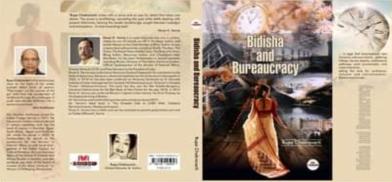Saga of a woman extraordinary
This is a story that evolves into a narration that finds true identity amid the hurdles of bureaucracy and life, especially of a woman’s

“…I was coming of age, certainly but with a well-defined understanding of global dynamics and a determined desire to learn. To learn from the best. As time would tell…” (pp.81) “Retirement will set me free as then I will speak for myself alone.” (pp.94).
Flipping through the pages of ‘Bidisha and Bureaucracy’ by Rupa Chakravarti, these lines seemed to connect themselves into a portrait of the understanding and learning the author speaks about in her second book, which is also an autobiographical reflection. As a woman anthropologist, author and educator myself, the book came to me as an important reminder of the erudite journey of all women, which the author seems to highlight through a retelling of her life’s voyage.
Overcoming bureaucratic hurdles
The expressions, representations, rhythm and repertoire of the prose expresses the sense of freedom which Chakravarti speaks about -- one which reflects from the heart as the desk of the author resumes its almost languid rhythm. Ensconced within the title of bureaucracy, the story of Bidisha seems to cut across all bureaucratic hurdles to reflect a story of a woman and the many women who seemed to have added an important colour to the easel of her life -- all of whom are or have been important parts of Chakravarti’s own life.
This includes the strong matriarch of the household: Dadi or Bidisha’s paternal grandmother, followed by her educationist mother, the female officers of the Indian Foreign Service, her forever loyal helps Jordette and Maya and of course her daughters Bindu and Indu.
The story of Bidisha has a male protagonist as well and other male characters, represented as counterparts, but their presence has only made the narrative more succinct -- a balance and an interlude between conversations and the various phases of the life of the protagonist Bidisha.
This is a difficult process as more often than not, identities and representations within retellings by women seem to get lost within the ambits of the patriarchal doldrums of storytelling. This could have been more so as Bidisha’s exposure to bureaucracy comes from her marriage to an officer at the Indian Foreign Services, just like Chakravarti’s own marriage to Ambassador Sarvajit Chakravarti and Former Secretary to the Government of India.
However, the story evolves into a narration which finds its true identity amidst the hurdles of bureaucracy and life, especially of a woman’s.
The story of Bidisha begins with an engagement breaking off of the protagonist with the family members worrying over her future -- with one exception -- Dadi, her paternal grandmother. Widowed at the tender age of 21, Bidisha stressed her significant influence on her life throughout the book.
Marries a diplomat
She kept assuring Bidisha to “never ever settle down” or look for the ordinary. Forever in her life, Bidisha held these words and the fragrance of jasmine from her home close to her heart. These always acted as her comfort space, amidst known and unknown paradigms alike. Soon, Bidisha is married to Apurbo, a young officer who has just begun his career in the Indian Foreign Service.
With a very brief stint in India, Bidisha’s journey began almost a pilgrimage of experiences starting with Spain and ending with Slovenia, 40 years later. In between, she had the fortune of finding the most from amidst overwhelming situations associated with bureaucratic duties and responsibilities, which also includes the spouses.
For many of the responsibilities Bidisha was unprepared, but managed to find solutions, remembering the words of her Dadi and the fragrance of the jasmine flowers from her home. Through her many and varied explorations, even over bus drives in remote locations, her discoveries stood out as enriching learning experiences, which were her very own.
Forty years later, when Bidisha and Apurbo returned home, after retirement, their two daughters were settled in various parts of the globe, having been exemplary students themselves. Bidisha returned to the very reminiscing smell from yesteryears, finding answers to many questions, knowing plenitude amidst scarcity and finding a strength of donning many hats and yet rediscovering oneself through the lanes charted out through one’s own diligent efforts.
Story from the heart
It is also important to mention the episode of mental breakdown that Bidisha went through. Having articulated it openly, Chakravarti speaks from the heart as she mentions about the gloom and the despair and also about the support of her family, including her parents, who all lend a patient and tender touch and the much-needed comfort which Bidisha’s troubled mind was seeking.
Amidst the comfort of home, Bidisha gathered the strength to finally fight the gloom and find an answer to her state of anguish. She emerged like the fragrance finding its identity.
The characters of the story, especially the women, lend power to the narrative. Reading through some of the formative stages of Bidisha’s life, I really coveted to know more about them and was looking forward to reading more about many of them, especially Dadi, a character I really ended up greatly admiring. Bidisha’s mother, taken after Chakravarti’s mother -- author, poet and educationist and former principal of Calcutta International School -- Nonda Chatterjee, is a well-known figure in the world of education.
I was also looking forward on reading more about her, especially as my interest grew after reading about the pivotal role in shaping the academic life of Bidisha’s elder daughter Bindu. Perhaps, the author might think about writing about the many inspiring women in her life. Such a work will be priceless.
Chakravarti, a global educator, with a graduate degree in English Honours from Presidency College (now known as Presidency University) has a Master’s degree in Education and accreditations from Cambridge University as Examiner in both English Language and Literature.
A versatile personality
A talented dancer, painter and singer, Chakravarti hails from a reputed lineage from Bangladesh, comprising of well-known educators. She has spent a lifetime teaching at various international schools, from the very junior and primary levels to high school across several countries.
She has also served as a language consultant in Business English to multinational corporations like Janssen-Cilag in Milan. As a trained ESL teacher, she has served as a coordinator in many international schools globally. As the story of Bidisha echoes, Chakravarti’s association with the desk and the pen seems to be a given -- coming from a family of reputed scholars and educationists. Chakravarti’s mother, Nonda Chatterjee, touched the hearts of hundreds of students who still remember her fondly at various occasions. The reviewer has the fortune of meeting some of them over many pluralistic discussions and they would always connect Chakravarti’s association with the education field and the pen as a gift from her mother.
Female identity is a process and Chakravarti’s work reflects the same, clarifying the distinctive engagement with her characters and indicating an analogous relationship between reader and characters and most importantly, being an expressive representation of memory. This book, successfully portraying a unique, whole and coherent identity, is a must read for all.
Title: Bidisha and Bureaucracy; Author: Rupa Chakravarti; Publisher: Aabs Publishing House, Kolkata; Pages: 161; Price: Rs 699)
(The reviewer is a visual anthropologist, author and international columnist)










Post a Comment